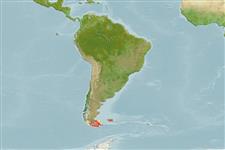Common names from other countries
Environment: milieu / climate zone / depth range / distribution range
Ecologia
; intervalo de profundidade 0 - 105 m (Ref. 83435). Temperate; 19°S - 57°S, 77°W - 55°W
Southeast Pacific and Southwest Atlantic: Argentina, Chile and Falkland Island.
Length at first maturity / Tamanho / Peso / Idade
Maturity: Lm ? range ? - ? cm Max length : 8.6 cm DL macho/indeterminado; (Ref. 83435)
This is an intertidal herbivore found on rocky substrates, stones, silt, shell and coral fragments from the lower intertidal areas (Ref. 87801).
Life cycle and mating behavior
Maturidade | Reprodução | Desova | Ovos | Fecundidade | Larvas
Members of the order Patellogastropoda are mostly gonochoric and broadcast spawners. Life cycle: Embryos develop into planktonic trocophore larvae and later into juvenile veligers before becoming fully grown adults.
Rosenberg, G. 2009. (Ref. 83435)
Categoria na Lista Vermelha da IUCN (Ref. 130435)
Categoria CITES (Ref. 108899)
Not Evaluated
Not Evaluated
Utilização humana
Pescarias: espécies comerciais
| FishSource |
Ferramentas
Mais informação
Idade/TamanhoCrescimentoComprimento-pesoComprimento-comprimentoMorfologiaLarvasAbundância
Fontes da internet
Estimates based on models
Preferred temperature
(Ref.
115969): 6.2 - 7.9, mean 7.2 (based on 26 cells).
Categoria de preço
Unknown.
